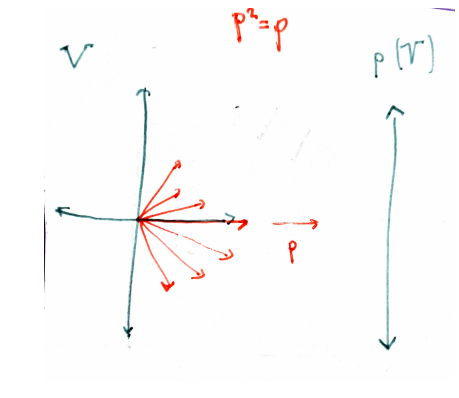Projections
Given a vector space
such that

Roughly speaking, for a projection you not only need to specify the "target" subspace, but also a "direction" along which to project (the red vectors in the picture above). So, in some sense, a projection gives us a decomposition of the vector space
In finite dimensional vector spaces
is the identity operator. . Every can be decomposed
Other properties of projections, valid even for infinite dimension, are:
- The only eigenvalues allowed for a projection are
and 1, even in complex vector spaces. - The product of two projection is not, in general, another projection. But it is true when they commute.
- Even more generally, projections are maps that have a right inverse:
When we work in a Hilbert space
that is, if it is a self adjoint operator.
They satisfy the following properties:
- Being orthogonal is equivalent to the fact that the image
and the kernel are orthogonal subspaces: let and then and so
Reciprocally, any projection
and
and therefore
- Given any closed subspace
of it there exist an orthogonal projection such that . The proof (wikipedia) goes through taking the infimum of the distance... - If
is an orthogonal projection, is an orthogonal projection and
Proof:
First,
And secondly,
- Orthogonal projections are bounded operators. From Cauchy-Swarth
and so
This is similar, in some sense, to saying that is continue.
Matrix Representation of Orthogonal Projections
Let’s start with the simplest case, where the subspace
Then the orthogonal projection of any vector
This can be written compactly as:
or, in Dirac notation:
Here:
is the column vector representing , is the row vector (or the conjugate transpose of ), - The operator
maps any to .
So this formula represents the projection operator onto the subspace spanned by.
This correspond to the matrix multiplication
Now, suppose we have a k-dimensional subspace
Let’s form a matrix
Note: Each
Then the orthogonal projection operator
The intuition is:
projects a vector into the coordinates in the subspace using the orthonormal basis . then maps those coordinates back into the original space as a linear combination of the basis vectors.